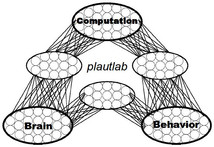Research
Normal and Impaired Word Reading
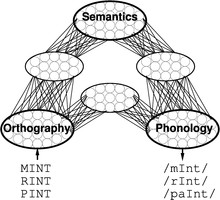
Much of my early work focused on word reading, both in normal skilled readers
and in brain-damaged patients with acquired reading disorders. Word reading
is a particularly informative domain for studying cognitive processes because
it involves learning to relate multiple sources of information—visual
(orthographic), phonological, and semantic—in a highly skilled manner. My
colleagues and I have developed artificial neural-network (connectionist)
models that exhibit many of the central characteristics of skilled reading,
including the influences of word frequency and spelling-sound consistency on
the time to pronounce words and the ability to pronounce word-like nonsense
letter strings (e.g., MAVE) and to distinguish them from real words in lexical
decision tasks (Plaut, McClelland, Seidenberg & Patterson, 1996). When the
models are damaged in various ways, they exhibit the major forms of acquired
dyslexia, including deep dyslexia, in which patients make semantic errors in
reading aloud (e.g., misreading YACHT as “boat”; Plaut & Shallice, 1993) and
surface dyslexia, in which patients produce regularization errors to exception
words (e.g., misreading YACHT as “yatched”; Woollams, Lambon Ralph, Plaut &
Patterson, 2007). Moreover, retraining the damaged models yields patterns of
recovery and generalization that are qualitatively similar to those found in
cognitive rehabilitation studies and has, in one instance (Plaut, 1996),
generated a specific prediction concerning the design of more effective
therapy for patients that later received direct empirical support (Kiran &
Thompson, 2003,
JSLHR).
- Plaut, D.C., and Shallice, T. (1993).
Deep dyslexia: A case study of connectionist neuropsychology.
Cognitive Neuropsychology, 10, 377-500.
- Plaut, D.C., McClelland, J.L., Seidenberg, M.S., and Patterson, K. (1996).
Understanding normal and impaired word reading: Computational
principles in quasi-regular domains.
Psychological Review, 103, 56-115.
- Plaut, D.C. (1996).
Relearning after damage in connectionist networks: Toward a theory
of rehabilitation.
Brain and Language, 52, 25-82.
- Woollams, A., Lambon Ralph, M.A., Plaut, D.C., and Patterson, K. (2007).
SD-squared: On the association between semantic dementia and surface
dyslexia.
Psychological Review, 114, 316-339.
Derivational and Inflectional Morphology
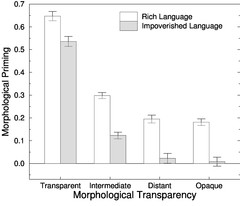
Traditional theories posit that complex words are composed of discrete units
called morphemes that contribute systematically to their meanings (e.g.,
TEACH+ER, GOVERN+MENT), but some words are awkward on this account (e.g.,
DRESS+ER is not someone who dresses; MOTH+ER, FATH+ER, SIST+ER, BROTH+ER and
all agents but the remaining parts are not coherent units). On a distributed
connectionist approach, however, morphology reflects a learned sensitivity to
the graded degree of systematicity among the surface forms of words and their
meanings, without the need to posit discrete segmentation. Explicit
simulations demonstrate that, in accordance with empirical findings (e.g.,
Velan, Frost, Deustch & Plaut, 2005), the degree of sensitivity to apparent
morphological structure in the absence of semantic similarity (e.g., BROTH+ER)
depends on the overall morphological richness of the language as a whole
(Plaut & Gonnerman, 2000). More generally, insights drawn from the
connectionist perspective on morphology and its debate with “rule-based”
accounts---in particular, the English past-tense system---have been
assimilated into many areas in the study of language, changing the focus of
research from abstract characterizations of linguistic competence to an
emphasis on the role of the statistical structure of language in acquisition
and processing (Seidenberg & Plaut, 2014).
- Plaut, D.C., and Gonnerman, L.M. (2000).
Are non-semantic morphological effects incompatible with a distributed
connectionist approach to lexical processing?
Language and Cognitive Processes, 15, 445-485.
- Velan, H., Frost, R., Deustch, A., and Plaut, D.C. (2005).
The processing of root morphemes in Hebrew: Contrasting localist and
distributed accounts.
Language and Cognitive Processes, 20, 169-206.
- Seidenberg, M.S., and Plaut, D.C. (2014).
Quasiregularity and its discontents: The legacy of the past tense debate.
Cognitive Science, 38, 1190-1228.
Semantics and Word Comprehension
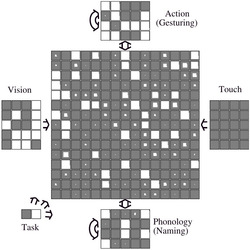 Optic aphasia.
Optic aphasia.
A longstanding debate regarding the representation of semantic knowledge is
whether such knowledge is represented in a single, amodal system or whether it
is organized into multiple subsystems based on modality of input or type of
information. A distributed connectionist perspective offers a middle ground,
in which semantic representations develop under the pressure of learning to
mediate between multiple input and output modalities in performing various
tasks, under a constraint to minimize connection length (and, hence, overall
axon volume). An implemented model provides a quantitative account of optic
aphasia---a selective deficit in naming visually presented objects---following
damage to connections from vision to regions of semantics near phonology
(Plaut, 2002). Additional implementations of the process by which visual
representations activate semantics account for 1) detailed patterns of
semantic priming and how these vary across individuals over the course of
development (Plaut & Booth, 2000); and 2) distinct patterns of impairment in word
and picture comprehension reflecting “access” versus “degraded-store” deficits
(Gotts & Plaut, 2002).
- Plaut, D.C., and Booth, J.R. (2000).
Individual and developmental differences in semantic priming: Empirical and
computational support for a single-mechanism account of lexical processing.
Psychological Review, 107, 786-823.
- Gotts, S.J., and Plaut, D.C. (2002).
The impact of synaptic depression following brain damage: A connectionist
account of "access/refractory" and "degraded-store" semantic impairments.
Cognitive, Affective, and Behavioral Neuroscience, 2,
187-213.
- Plaut, D.C. (2002).
Graded modality-specific specialization in semantics:
A computational account of optic aphasia.
Cognitive Neuropsychology, 19, 603-639.
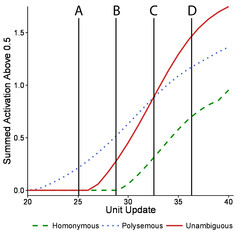 Semantic ambiguity.
Semantic ambiguity.
The meanings of most words depend on the context in
which they occur (e.g.,
vs. BANK). Developing a theory of how
comprehension of semantically ambiguous words are understood is a critical
aspect of any theory of word or discourse comprehension. However, success to
date has been limited by discrepancies in the effects of relatedness of
meaning observed within and between tasks. Further, existing accounts are
underspecified, narrow in scope, and mutually inconsistent. The current work
introduces the semantic settling dynamics account of semantic
ambiguity resolution, in which the discrepant effects are explained by the
temporal settling dynamics in semantics within a neural network, and how these
dynamics interact with the semantic representations of ambiguous words over
time. This account stands as an alternative to one based on the configuration
of the decision system across tasks (Hino, Pexman, & Lupker, 2006, Journal
of Memory and Language). The proposed account reconciles a wide body of
disparate results within a single unified mechanistic account, is supported by
initial investigations that vary processing time to modulate semantic
ambiguity effects, and generates targeted predictions for future
computational, neural, and behavioral research.
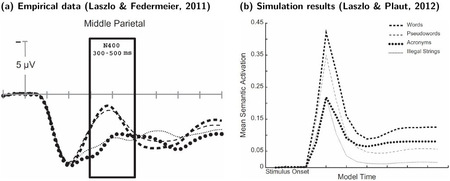 N400.
The study of the N400 event-related brain potential has provided fundamental
insights into the nature of real-time comprehension processes, and its
amplitude is modulated by a wide variety of stimulus and context factors. It
is generally thought to reflect the difficulty of semantic access, but
formulating a precise characterization of this process has proved difficult.
Laszlo and colleagues (Laszlo & Plaut, 2012, Brain and Language,
120, 271-281; Laszlo & Armstrong, 2014, Brain and Language,
132, 22-27) used physiologically constrained neural networks to model the N400
as transient over-activation within semantic representations, arising as a
consequence of the distribution of excitation and inhibition within and between
cortical areas. The current work extends this approach to successfully model
effects on both N400 amplitudes and behavior of word frequency, semantic
richness, repetition, semantic and associative priming, and orthographic
neighborhood size. The account is argued to be preferable to one based on
"semantic prediction error" (Rabovsky & McRae, 2014, Cognition,
132, 68-98) for a number of reasons, the most fundamental of which is
that the current model actually produces N400-like waveforms in its real-time
activation dynamics.
N400.
The study of the N400 event-related brain potential has provided fundamental
insights into the nature of real-time comprehension processes, and its
amplitude is modulated by a wide variety of stimulus and context factors. It
is generally thought to reflect the difficulty of semantic access, but
formulating a precise characterization of this process has proved difficult.
Laszlo and colleagues (Laszlo & Plaut, 2012, Brain and Language,
120, 271-281; Laszlo & Armstrong, 2014, Brain and Language,
132, 22-27) used physiologically constrained neural networks to model the N400
as transient over-activation within semantic representations, arising as a
consequence of the distribution of excitation and inhibition within and between
cortical areas. The current work extends this approach to successfully model
effects on both N400 amplitudes and behavior of word frequency, semantic
richness, repetition, semantic and associative priming, and orthographic
neighborhood size. The account is argued to be preferable to one based on
"semantic prediction error" (Rabovsky & McRae, 2014, Cognition,
132, 68-98) for a number of reasons, the most fundamental of which is
that the current model actually produces N400-like waveforms in its real-time
activation dynamics.
Sequential Behavior
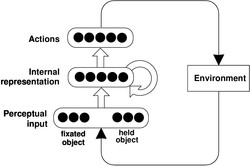 Routine action.
In everyday tasks, selecting actions in the proper sequence requires a
continuously updated representation of temporal context. Many existing models
address this problem by positing a hierarchy of processing units, mirroring
the roughly hierarchical structure of naturalistic tasks themselves. Although
intuitive, such an approach has led to a number of difficulties, including a
reliance on overly rigid sequencing mechanisms and a limited ability to
address both learning and context sensitivity in behavior. A sequential
neural network, by contrast, can to deal flexibly with a complex set of
sequencing constraints, encoding contextual information at multiple
time-scales within a single, distributed internal representation (Botvinick &
Plaut, 2004). The model not only accounts for skilled action performance, but
also everyday “slips of action” that normal individuals commit under
distraction, as well as more severe degradation in performance following
damage, as observed in ideational apraxia. An analogous model in the domain
of language acquisition and processing. accounts for the integration of
semantic and syntactic constraints on sentence processing (Rohde & Plaut,
1999). Finally, the same type of model, at a shorter timescale, provides a
parsimonious account for numerous benchmark phenomena in the domain of
immediate serial recall (Botvinick & Plaut, 2006), including data that have
been considered to preclude the application of neural networks in this domain.
Unlike most competing accounts, the model deals naturally with findings
concerning the role of background knowledge in serial recall, and makes
contact with relevant neuroscientific data.
Routine action.
In everyday tasks, selecting actions in the proper sequence requires a
continuously updated representation of temporal context. Many existing models
address this problem by positing a hierarchy of processing units, mirroring
the roughly hierarchical structure of naturalistic tasks themselves. Although
intuitive, such an approach has led to a number of difficulties, including a
reliance on overly rigid sequencing mechanisms and a limited ability to
address both learning and context sensitivity in behavior. A sequential
neural network, by contrast, can to deal flexibly with a complex set of
sequencing constraints, encoding contextual information at multiple
time-scales within a single, distributed internal representation (Botvinick &
Plaut, 2004). The model not only accounts for skilled action performance, but
also everyday “slips of action” that normal individuals commit under
distraction, as well as more severe degradation in performance following
damage, as observed in ideational apraxia. An analogous model in the domain
of language acquisition and processing. accounts for the integration of
semantic and syntactic constraints on sentence processing (Rohde & Plaut,
1999). Finally, the same type of model, at a shorter timescale, provides a
parsimonious account for numerous benchmark phenomena in the domain of
immediate serial recall (Botvinick & Plaut, 2006), including data that have
been considered to preclude the application of neural networks in this domain.
Unlike most competing accounts, the model deals naturally with findings
concerning the role of background knowledge in serial recall, and makes
contact with relevant neuroscientific data.
- Rohde, D.L.T., and Plaut, D.C. (1999).
Language acquisition in the absence of explicit negative
evidence: How important is starting small?
Cognition, 72, 67-109.
- Botvinick, M., and Plaut, D.C. (2004).
Doing without schema hierarchies: A recurrent connectionist approach to
normal and impaired routine sequential action.
Psychological Review, 111, 395-429.
- Botvinick, M., and Plaut, D.C. (2006).
Short-term memory for serial order: A recurrent neural network model.
Psychological Review, 113, 201-233.
 Statistical learning.
Statistical learning is often cast as a means of discovering the units of
perception, such as words and objects, and representing them as explicit
"chunks". However, entities are not undifferentiated wholes but often
contain parts that contribute systematically to their meanings. Studies of
incidental auditory or visual statistical learning suggest that, as
participants learn about wholes they become insensitive to parts embedded
within them (Fiser & Aslin, 2005; Giroux & Rey, 2009), but this seems
difficult to reconcile with a broad range of findings in which parts and
wholes work together to contribute to behavior. In the current work, we adopt
a computational approach, based on learning in artificial neural networks,
that is capable of capturing statistical structure at multiple levels of
representation simultaneously and yet eschews the notion of explicit chunks.
Rather, the extent to which a particular subset of the input in a particular
context is represented in a coherent manner is a matter of degree, and the
extent to which structure at one level of analysis cooperates or competes with
structure at other levels is not prespecified but arises naturally through
incidental learning. We show that the approach accounts for a wide range of
findings concerning the relationship between parts and wholes in auditory and
visual statistical learning, including some previously thought to be
problematic for neural network approaches.
Statistical learning.
Statistical learning is often cast as a means of discovering the units of
perception, such as words and objects, and representing them as explicit
"chunks". However, entities are not undifferentiated wholes but often
contain parts that contribute systematically to their meanings. Studies of
incidental auditory or visual statistical learning suggest that, as
participants learn about wholes they become insensitive to parts embedded
within them (Fiser & Aslin, 2005; Giroux & Rey, 2009), but this seems
difficult to reconcile with a broad range of findings in which parts and
wholes work together to contribute to behavior. In the current work, we adopt
a computational approach, based on learning in artificial neural networks,
that is capable of capturing statistical structure at multiple levels of
representation simultaneously and yet eschews the notion of explicit chunks.
Rather, the extent to which a particular subset of the input in a particular
context is represented in a coherent manner is a matter of degree, and the
extent to which structure at one level of analysis cooperates or competes with
structure at other levels is not prespecified but arises naturally through
incidental learning. We show that the approach accounts for a wide range of
findings concerning the relationship between parts and wholes in auditory and
visual statistical learning, including some previously thought to be
problematic for neural network approaches.
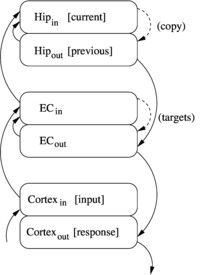 Rapid sequence learning.
We have developed a model of rapid sequence learning by the hippocampus, and
applied it to account for repetition effects in immediate serial recall (ISR)
and the discovery of structure in auditory statistical learning. The model
supports one-trial learning of novel sequences through fast predictive
learning from sparse but structure-sensitive hippocampal representations of
items and the contexts in which they occur. In the model, the accumulation of
learning effects across trials gives rise to an advantage for whole-list
repetition in ISR, as well as reductions in this effect when repetitions vary
in temporal grouping, in their onsets, or in the order of items. Shared
structure across lists, such as repetition of item-item and item-position
associations, accumulates with sufficient exposure, reflecting
structure-sensitive overlap among the sparse representations. This same
sensitivity discovers the statistical structure within continuous streams of
input, as observed in standard statistical learning paradigms. Analyses show
that the structure of the training environment systematically influences the
degree to which item and position information are represented independently
versus conjunctively, and the resulting representations are broadly consistent
with functional neuroimaging data on changes in representational similarity
during sequential learning. The model shares important properties with a
number of existing models and can be viewed as an integration of them that
accounts for a broader range of phenomena.
Rapid sequence learning.
We have developed a model of rapid sequence learning by the hippocampus, and
applied it to account for repetition effects in immediate serial recall (ISR)
and the discovery of structure in auditory statistical learning. The model
supports one-trial learning of novel sequences through fast predictive
learning from sparse but structure-sensitive hippocampal representations of
items and the contexts in which they occur. In the model, the accumulation of
learning effects across trials gives rise to an advantage for whole-list
repetition in ISR, as well as reductions in this effect when repetitions vary
in temporal grouping, in their onsets, or in the order of items. Shared
structure across lists, such as repetition of item-item and item-position
associations, accumulates with sufficient exposure, reflecting
structure-sensitive overlap among the sparse representations. This same
sensitivity discovers the statistical structure within continuous streams of
input, as observed in standard statistical learning paradigms. Analyses show
that the structure of the training environment systematically influences the
degree to which item and position information are represented independently
versus conjunctively, and the resulting representations are broadly consistent
with functional neuroimaging data on changes in representational similarity
during sequential learning. The model shares important properties with a
number of existing models and can be viewed as an integration of them that
accounts for a broader range of phenomena.
- Nakayama, M., and Plaut, D.C. (submitted). A hippocampal model of
rapid sequence learning applied to immediate serial recall and statistical
learning. Psychological Review.
Neural Representations
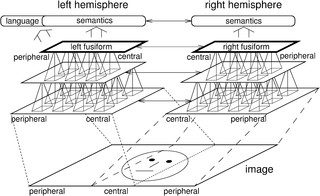 Faces and words.
The neural mechanisms supporting visual recognition of faces, words, and other
objects are increasingly conceptualized as a distributed but integrated system
that become organized gradually over the course of development, rather than as
a set of individual, specialized regions subserving particular visual domains
(Behrmann & Plaut, 2013). In understanding the emergence of this
organization, we adopt a specific theoretical perspective in which visual
recognition involves topographically-constrained cooperation and competition
among multiple, interacting regions, each of which is only partially selective
for a specific domain. When applied to faces and words in an explicit
computational simulation (Plaut & Behrmann, 2011), these domains compete to be
near high-acuity visual information in each hemisphere; words become more
left-lateralized to cooperate with language-related information and, in
response, faces subsequently become more right-lateralized. The account thus
makes specific and otherwise unexpected predictions—supported by subsequent
empirical studies (e.g., Behrmann & Plaut, 2014; Nestor, Behrmann & Plaut,
2013; Nestor, Plaut & Behrmann, 2013)—concerning the co-mingling of these two
seemingly unrelated domains over the course of development, in
neurophysiological measures of recognition in both children and adults, and in
graded patterns of impairment in both domains following unilateral brain
damage. The research offers a novel theoretical perspective that has broad
implications for theories of normal and atypical cognitive and neural
development, and for instruction and remediation.
Faces and words.
The neural mechanisms supporting visual recognition of faces, words, and other
objects are increasingly conceptualized as a distributed but integrated system
that become organized gradually over the course of development, rather than as
a set of individual, specialized regions subserving particular visual domains
(Behrmann & Plaut, 2013). In understanding the emergence of this
organization, we adopt a specific theoretical perspective in which visual
recognition involves topographically-constrained cooperation and competition
among multiple, interacting regions, each of which is only partially selective
for a specific domain. When applied to faces and words in an explicit
computational simulation (Plaut & Behrmann, 2011), these domains compete to be
near high-acuity visual information in each hemisphere; words become more
left-lateralized to cooperate with language-related information and, in
response, faces subsequently become more right-lateralized. The account thus
makes specific and otherwise unexpected predictions—supported by subsequent
empirical studies (e.g., Behrmann & Plaut, 2014; Nestor, Behrmann & Plaut,
2013; Nestor, Plaut & Behrmann, 2013)—concerning the co-mingling of these two
seemingly unrelated domains over the course of development, in
neurophysiological measures of recognition in both children and adults, and in
graded patterns of impairment in both domains following unilateral brain
damage. The research offers a novel theoretical perspective that has broad
implications for theories of normal and atypical cognitive and neural
development, and for instruction and remediation.
- Plaut, D.C., and Behrmann, M. (2011).
Complementary neural representations for faces and words: A computational
exploration.
Cognitive Neuropsychology, 28, 251-275.
- Nestor, A., Plaut, D.C., and Behrmann, M. (2011).
Unraveling the distributed neural code of facial identity through
spatiotemporal pattern analysis.
Proceedings of the National Academy of Science USA, 108, 9998-10003.
- Behrmann, M., and Plaut, D.C. (2013).
Distributed circuits, not circumscribed centers, mediate visual cognition.
Trends in Cognitive Sciences, 17, 210-219.
- Nestor, A., Behrmann, M., and Plaut, D.C. (2013).
The neural basis of visual word form processing: A multivariate investigation.
Cerebral Cortex, 23, 1673-1684.
- Behrmann, M., and Plaut, D.C. (2014).
Bilateral hemispheric representation of words and faces: Evidence from word
impairments in prosopagnosia and face impairments in pure alexia.
Cerebral Cortex, 24, 1102-1118.
- Robinson, A.K., Plaut, D.C., and Behrmann, M. (2017).
Word and face processing engage overlapping distributed networks: Evidence
from RSVP and EEG investigations.
Journal of Experimental Psychology: General, 146, 943-961.
doi:10.1037/xge0000302
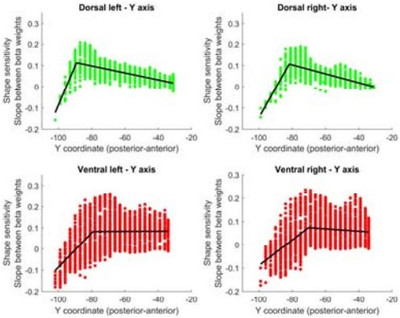 Dorsal object representations.
The cortical visual system is almost universally thought to be segregated into
two anatomically and functionally distinct pathways: a ventral
occipito-temporal pathway that subserves object perception, and a dorsal
occipito-parietal pathway that subserves object localization and visually
guided action. Accumulating evidence from both human and non-human primate
studies, however, challenges this binary distinction and suggests that regions
in the dorsal pathway contain object representations that are independent of
those in ventral cortex and that play a functional role in object perception.
We are exploring the nature of dorsal object representations through a
combination of behavioral, neuropsychological, neuroimaging, and computational
work. We propose a graded functional account of the anatomical organization,
functional contributions and origins of these representations in the service
of perception and action.
Dorsal object representations.
The cortical visual system is almost universally thought to be segregated into
two anatomically and functionally distinct pathways: a ventral
occipito-temporal pathway that subserves object perception, and a dorsal
occipito-parietal pathway that subserves object localization and visually
guided action. Accumulating evidence from both human and non-human primate
studies, however, challenges this binary distinction and suggests that regions
in the dorsal pathway contain object representations that are independent of
those in ventral cortex and that play a functional role in object perception.
We are exploring the nature of dorsal object representations through a
combination of behavioral, neuropsychological, neuroimaging, and computational
work. We propose a graded functional account of the anatomical organization,
functional contributions and origins of these representations in the service
of perception and action.
- Freud, E., Plaut, D.C., and Behrmann, M. (2016).
"What" is happening in the dorsal visual pathway.
Trends in Cognitive Sciences, 20, 773-784.
doi:10.1016/j.tics.2016.08.003
- Freud, E., Culham, J., Plaut, D.C. and Behrmann, M. (2017).
The large-scale organization of shape processing in the ventral and dorsal pathways.
eLife,6, e27576.
doi:10.7554/eLife.27576
- Freud, E., Plaut, D.C. and Behrmann, M. (submitted).
Protracted developmental trajectory of shape processing along the two visual pathways.
eLife.
 Much of my early work focused on word reading, both in normal skilled readers
and in brain-damaged patients with acquired reading disorders. Word reading
is a particularly informative domain for studying cognitive processes because
it involves learning to relate multiple sources of information—visual
(orthographic), phonological, and semantic—in a highly skilled manner. My
colleagues and I have developed artificial neural-network (connectionist)
models that exhibit many of the central characteristics of skilled reading,
including the influences of word frequency and spelling-sound consistency on
the time to pronounce words and the ability to pronounce word-like nonsense
letter strings (e.g., MAVE) and to distinguish them from real words in lexical
decision tasks (Plaut, McClelland, Seidenberg & Patterson, 1996). When the
models are damaged in various ways, they exhibit the major forms of acquired
dyslexia, including deep dyslexia, in which patients make semantic errors in
reading aloud (e.g., misreading YACHT as “boat”; Plaut & Shallice, 1993) and
surface dyslexia, in which patients produce regularization errors to exception
words (e.g., misreading YACHT as “yatched”; Woollams, Lambon Ralph, Plaut &
Patterson, 2007). Moreover, retraining the damaged models yields patterns of
recovery and generalization that are qualitatively similar to those found in
cognitive rehabilitation studies and has, in one instance (Plaut, 1996),
generated a specific prediction concerning the design of more effective
therapy for patients that later received direct empirical support (Kiran &
Thompson, 2003, JSLHR).
Much of my early work focused on word reading, both in normal skilled readers
and in brain-damaged patients with acquired reading disorders. Word reading
is a particularly informative domain for studying cognitive processes because
it involves learning to relate multiple sources of information—visual
(orthographic), phonological, and semantic—in a highly skilled manner. My
colleagues and I have developed artificial neural-network (connectionist)
models that exhibit many of the central characteristics of skilled reading,
including the influences of word frequency and spelling-sound consistency on
the time to pronounce words and the ability to pronounce word-like nonsense
letter strings (e.g., MAVE) and to distinguish them from real words in lexical
decision tasks (Plaut, McClelland, Seidenberg & Patterson, 1996). When the
models are damaged in various ways, they exhibit the major forms of acquired
dyslexia, including deep dyslexia, in which patients make semantic errors in
reading aloud (e.g., misreading YACHT as “boat”; Plaut & Shallice, 1993) and
surface dyslexia, in which patients produce regularization errors to exception
words (e.g., misreading YACHT as “yatched”; Woollams, Lambon Ralph, Plaut &
Patterson, 2007). Moreover, retraining the damaged models yields patterns of
recovery and generalization that are qualitatively similar to those found in
cognitive rehabilitation studies and has, in one instance (Plaut, 1996),
generated a specific prediction concerning the design of more effective
therapy for patients that later received direct empirical support (Kiran &
Thompson, 2003, JSLHR).
 Traditional theories posit that complex words are composed of discrete units
called morphemes that contribute systematically to their meanings (e.g.,
TEACH+ER, GOVERN+MENT), but some words are awkward on this account (e.g.,
DRESS+ER is not someone who dresses; MOTH+ER, FATH+ER, SIST+ER, BROTH+ER and
all agents but the remaining parts are not coherent units). On a distributed
connectionist approach, however, morphology reflects a learned sensitivity to
the graded degree of systematicity among the surface forms of words and their
meanings, without the need to posit discrete segmentation. Explicit
simulations demonstrate that, in accordance with empirical findings (e.g.,
Velan, Frost, Deustch & Plaut, 2005), the degree of sensitivity to apparent
morphological structure in the absence of semantic similarity (e.g., BROTH+ER)
depends on the overall morphological richness of the language as a whole
(Plaut & Gonnerman, 2000). More generally, insights drawn from the
connectionist perspective on morphology and its debate with “rule-based”
accounts---in particular, the English past-tense system---have been
assimilated into many areas in the study of language, changing the focus of
research from abstract characterizations of linguistic competence to an
emphasis on the role of the statistical structure of language in acquisition
and processing (Seidenberg & Plaut, 2014).
Traditional theories posit that complex words are composed of discrete units
called morphemes that contribute systematically to their meanings (e.g.,
TEACH+ER, GOVERN+MENT), but some words are awkward on this account (e.g.,
DRESS+ER is not someone who dresses; MOTH+ER, FATH+ER, SIST+ER, BROTH+ER and
all agents but the remaining parts are not coherent units). On a distributed
connectionist approach, however, morphology reflects a learned sensitivity to
the graded degree of systematicity among the surface forms of words and their
meanings, without the need to posit discrete segmentation. Explicit
simulations demonstrate that, in accordance with empirical findings (e.g.,
Velan, Frost, Deustch & Plaut, 2005), the degree of sensitivity to apparent
morphological structure in the absence of semantic similarity (e.g., BROTH+ER)
depends on the overall morphological richness of the language as a whole
(Plaut & Gonnerman, 2000). More generally, insights drawn from the
connectionist perspective on morphology and its debate with “rule-based”
accounts---in particular, the English past-tense system---have been
assimilated into many areas in the study of language, changing the focus of
research from abstract characterizations of linguistic competence to an
emphasis on the role of the statistical structure of language in acquisition
and processing (Seidenberg & Plaut, 2014).
 Optic aphasia.
A longstanding debate regarding the representation of semantic knowledge is
whether such knowledge is represented in a single, amodal system or whether it
is organized into multiple subsystems based on modality of input or type of
information. A distributed connectionist perspective offers a middle ground,
in which semantic representations develop under the pressure of learning to
mediate between multiple input and output modalities in performing various
tasks, under a constraint to minimize connection length (and, hence, overall
axon volume). An implemented model provides a quantitative account of optic
aphasia---a selective deficit in naming visually presented objects---following
damage to connections from vision to regions of semantics near phonology
(Plaut, 2002). Additional implementations of the process by which visual
representations activate semantics account for 1) detailed patterns of
semantic priming and how these vary across individuals over the course of
development (Plaut & Booth, 2000); and 2) distinct patterns of impairment in word
and picture comprehension reflecting “access” versus “degraded-store” deficits
(Gotts & Plaut, 2002).
Optic aphasia.
A longstanding debate regarding the representation of semantic knowledge is
whether such knowledge is represented in a single, amodal system or whether it
is organized into multiple subsystems based on modality of input or type of
information. A distributed connectionist perspective offers a middle ground,
in which semantic representations develop under the pressure of learning to
mediate between multiple input and output modalities in performing various
tasks, under a constraint to minimize connection length (and, hence, overall
axon volume). An implemented model provides a quantitative account of optic
aphasia---a selective deficit in naming visually presented objects---following
damage to connections from vision to regions of semantics near phonology
(Plaut, 2002). Additional implementations of the process by which visual
representations activate semantics account for 1) detailed patterns of
semantic priming and how these vary across individuals over the course of
development (Plaut & Booth, 2000); and 2) distinct patterns of impairment in word
and picture comprehension reflecting “access” versus “degraded-store” deficits
(Gotts & Plaut, 2002).
 Semantic ambiguity.
The meanings of most words depend on the context in
which they occur (e.g.,
Semantic ambiguity.
The meanings of most words depend on the context in
which they occur (e.g.,  N400.
The study of the N400 event-related brain potential has provided fundamental
insights into the nature of real-time comprehension processes, and its
amplitude is modulated by a wide variety of stimulus and context factors. It
is generally thought to reflect the difficulty of semantic access, but
formulating a precise characterization of this process has proved difficult.
Laszlo and colleagues (Laszlo & Plaut, 2012, Brain and Language,
120, 271-281; Laszlo & Armstrong, 2014, Brain and Language,
132, 22-27) used physiologically constrained neural networks to model the N400
as transient over-activation within semantic representations, arising as a
consequence of the distribution of excitation and inhibition within and between
cortical areas. The current work extends this approach to successfully model
effects on both N400 amplitudes and behavior of word frequency, semantic
richness, repetition, semantic and associative priming, and orthographic
neighborhood size. The account is argued to be preferable to one based on
"semantic prediction error" (Rabovsky & McRae, 2014, Cognition,
132, 68-98) for a number of reasons, the most fundamental of which is
that the current model actually produces N400-like waveforms in its real-time
activation dynamics.
N400.
The study of the N400 event-related brain potential has provided fundamental
insights into the nature of real-time comprehension processes, and its
amplitude is modulated by a wide variety of stimulus and context factors. It
is generally thought to reflect the difficulty of semantic access, but
formulating a precise characterization of this process has proved difficult.
Laszlo and colleagues (Laszlo & Plaut, 2012, Brain and Language,
120, 271-281; Laszlo & Armstrong, 2014, Brain and Language,
132, 22-27) used physiologically constrained neural networks to model the N400
as transient over-activation within semantic representations, arising as a
consequence of the distribution of excitation and inhibition within and between
cortical areas. The current work extends this approach to successfully model
effects on both N400 amplitudes and behavior of word frequency, semantic
richness, repetition, semantic and associative priming, and orthographic
neighborhood size. The account is argued to be preferable to one based on
"semantic prediction error" (Rabovsky & McRae, 2014, Cognition,
132, 68-98) for a number of reasons, the most fundamental of which is
that the current model actually produces N400-like waveforms in its real-time
activation dynamics.
 Routine action.
In everyday tasks, selecting actions in the proper sequence requires a
continuously updated representation of temporal context. Many existing models
address this problem by positing a hierarchy of processing units, mirroring
the roughly hierarchical structure of naturalistic tasks themselves. Although
intuitive, such an approach has led to a number of difficulties, including a
reliance on overly rigid sequencing mechanisms and a limited ability to
address both learning and context sensitivity in behavior. A sequential
neural network, by contrast, can to deal flexibly with a complex set of
sequencing constraints, encoding contextual information at multiple
time-scales within a single, distributed internal representation (Botvinick &
Plaut, 2004). The model not only accounts for skilled action performance, but
also everyday “slips of action” that normal individuals commit under
distraction, as well as more severe degradation in performance following
damage, as observed in ideational apraxia. An analogous model in the domain
of language acquisition and processing. accounts for the integration of
semantic and syntactic constraints on sentence processing (Rohde & Plaut,
1999). Finally, the same type of model, at a shorter timescale, provides a
parsimonious account for numerous benchmark phenomena in the domain of
immediate serial recall (Botvinick & Plaut, 2006), including data that have
been considered to preclude the application of neural networks in this domain.
Unlike most competing accounts, the model deals naturally with findings
concerning the role of background knowledge in serial recall, and makes
contact with relevant neuroscientific data.
Routine action.
In everyday tasks, selecting actions in the proper sequence requires a
continuously updated representation of temporal context. Many existing models
address this problem by positing a hierarchy of processing units, mirroring
the roughly hierarchical structure of naturalistic tasks themselves. Although
intuitive, such an approach has led to a number of difficulties, including a
reliance on overly rigid sequencing mechanisms and a limited ability to
address both learning and context sensitivity in behavior. A sequential
neural network, by contrast, can to deal flexibly with a complex set of
sequencing constraints, encoding contextual information at multiple
time-scales within a single, distributed internal representation (Botvinick &
Plaut, 2004). The model not only accounts for skilled action performance, but
also everyday “slips of action” that normal individuals commit under
distraction, as well as more severe degradation in performance following
damage, as observed in ideational apraxia. An analogous model in the domain
of language acquisition and processing. accounts for the integration of
semantic and syntactic constraints on sentence processing (Rohde & Plaut,
1999). Finally, the same type of model, at a shorter timescale, provides a
parsimonious account for numerous benchmark phenomena in the domain of
immediate serial recall (Botvinick & Plaut, 2006), including data that have
been considered to preclude the application of neural networks in this domain.
Unlike most competing accounts, the model deals naturally with findings
concerning the role of background knowledge in serial recall, and makes
contact with relevant neuroscientific data.
 Statistical learning.
Statistical learning is often cast as a means of discovering the units of
perception, such as words and objects, and representing them as explicit
"chunks". However, entities are not undifferentiated wholes but often
contain parts that contribute systematically to their meanings. Studies of
incidental auditory or visual statistical learning suggest that, as
participants learn about wholes they become insensitive to parts embedded
within them (Fiser & Aslin, 2005; Giroux & Rey, 2009), but this seems
difficult to reconcile with a broad range of findings in which parts and
wholes work together to contribute to behavior. In the current work, we adopt
a computational approach, based on learning in artificial neural networks,
that is capable of capturing statistical structure at multiple levels of
representation simultaneously and yet eschews the notion of explicit chunks.
Rather, the extent to which a particular subset of the input in a particular
context is represented in a coherent manner is a matter of degree, and the
extent to which structure at one level of analysis cooperates or competes with
structure at other levels is not prespecified but arises naturally through
incidental learning. We show that the approach accounts for a wide range of
findings concerning the relationship between parts and wholes in auditory and
visual statistical learning, including some previously thought to be
problematic for neural network approaches.
Statistical learning.
Statistical learning is often cast as a means of discovering the units of
perception, such as words and objects, and representing them as explicit
"chunks". However, entities are not undifferentiated wholes but often
contain parts that contribute systematically to their meanings. Studies of
incidental auditory or visual statistical learning suggest that, as
participants learn about wholes they become insensitive to parts embedded
within them (Fiser & Aslin, 2005; Giroux & Rey, 2009), but this seems
difficult to reconcile with a broad range of findings in which parts and
wholes work together to contribute to behavior. In the current work, we adopt
a computational approach, based on learning in artificial neural networks,
that is capable of capturing statistical structure at multiple levels of
representation simultaneously and yet eschews the notion of explicit chunks.
Rather, the extent to which a particular subset of the input in a particular
context is represented in a coherent manner is a matter of degree, and the
extent to which structure at one level of analysis cooperates or competes with
structure at other levels is not prespecified but arises naturally through
incidental learning. We show that the approach accounts for a wide range of
findings concerning the relationship between parts and wholes in auditory and
visual statistical learning, including some previously thought to be
problematic for neural network approaches.
 Rapid sequence learning.
We have developed a model of rapid sequence learning by the hippocampus, and
applied it to account for repetition effects in immediate serial recall (ISR)
and the discovery of structure in auditory statistical learning. The model
supports one-trial learning of novel sequences through fast predictive
learning from sparse but structure-sensitive hippocampal representations of
items and the contexts in which they occur. In the model, the accumulation of
learning effects across trials gives rise to an advantage for whole-list
repetition in ISR, as well as reductions in this effect when repetitions vary
in temporal grouping, in their onsets, or in the order of items. Shared
structure across lists, such as repetition of item-item and item-position
associations, accumulates with sufficient exposure, reflecting
structure-sensitive overlap among the sparse representations. This same
sensitivity discovers the statistical structure within continuous streams of
input, as observed in standard statistical learning paradigms. Analyses show
that the structure of the training environment systematically influences the
degree to which item and position information are represented independently
versus conjunctively, and the resulting representations are broadly consistent
with functional neuroimaging data on changes in representational similarity
during sequential learning. The model shares important properties with a
number of existing models and can be viewed as an integration of them that
accounts for a broader range of phenomena.
Rapid sequence learning.
We have developed a model of rapid sequence learning by the hippocampus, and
applied it to account for repetition effects in immediate serial recall (ISR)
and the discovery of structure in auditory statistical learning. The model
supports one-trial learning of novel sequences through fast predictive
learning from sparse but structure-sensitive hippocampal representations of
items and the contexts in which they occur. In the model, the accumulation of
learning effects across trials gives rise to an advantage for whole-list
repetition in ISR, as well as reductions in this effect when repetitions vary
in temporal grouping, in their onsets, or in the order of items. Shared
structure across lists, such as repetition of item-item and item-position
associations, accumulates with sufficient exposure, reflecting
structure-sensitive overlap among the sparse representations. This same
sensitivity discovers the statistical structure within continuous streams of
input, as observed in standard statistical learning paradigms. Analyses show
that the structure of the training environment systematically influences the
degree to which item and position information are represented independently
versus conjunctively, and the resulting representations are broadly consistent
with functional neuroimaging data on changes in representational similarity
during sequential learning. The model shares important properties with a
number of existing models and can be viewed as an integration of them that
accounts for a broader range of phenomena.
 Faces and words.
The neural mechanisms supporting visual recognition of faces, words, and other
objects are increasingly conceptualized as a distributed but integrated system
that become organized gradually over the course of development, rather than as
a set of individual, specialized regions subserving particular visual domains
(Behrmann & Plaut, 2013). In understanding the emergence of this
organization, we adopt a specific theoretical perspective in which visual
recognition involves topographically-constrained cooperation and competition
among multiple, interacting regions, each of which is only partially selective
for a specific domain. When applied to faces and words in an explicit
computational simulation (Plaut & Behrmann, 2011), these domains compete to be
near high-acuity visual information in each hemisphere; words become more
left-lateralized to cooperate with language-related information and, in
response, faces subsequently become more right-lateralized. The account thus
makes specific and otherwise unexpected predictions—supported by subsequent
empirical studies (e.g., Behrmann & Plaut, 2014; Nestor, Behrmann & Plaut,
2013; Nestor, Plaut & Behrmann, 2013)—concerning the co-mingling of these two
seemingly unrelated domains over the course of development, in
neurophysiological measures of recognition in both children and adults, and in
graded patterns of impairment in both domains following unilateral brain
damage. The research offers a novel theoretical perspective that has broad
implications for theories of normal and atypical cognitive and neural
development, and for instruction and remediation.
Faces and words.
The neural mechanisms supporting visual recognition of faces, words, and other
objects are increasingly conceptualized as a distributed but integrated system
that become organized gradually over the course of development, rather than as
a set of individual, specialized regions subserving particular visual domains
(Behrmann & Plaut, 2013). In understanding the emergence of this
organization, we adopt a specific theoretical perspective in which visual
recognition involves topographically-constrained cooperation and competition
among multiple, interacting regions, each of which is only partially selective
for a specific domain. When applied to faces and words in an explicit
computational simulation (Plaut & Behrmann, 2011), these domains compete to be
near high-acuity visual information in each hemisphere; words become more
left-lateralized to cooperate with language-related information and, in
response, faces subsequently become more right-lateralized. The account thus
makes specific and otherwise unexpected predictions—supported by subsequent
empirical studies (e.g., Behrmann & Plaut, 2014; Nestor, Behrmann & Plaut,
2013; Nestor, Plaut & Behrmann, 2013)—concerning the co-mingling of these two
seemingly unrelated domains over the course of development, in
neurophysiological measures of recognition in both children and adults, and in
graded patterns of impairment in both domains following unilateral brain
damage. The research offers a novel theoretical perspective that has broad
implications for theories of normal and atypical cognitive and neural
development, and for instruction and remediation.
 Dorsal object representations.
The cortical visual system is almost universally thought to be segregated into
two anatomically and functionally distinct pathways: a ventral
occipito-temporal pathway that subserves object perception, and a dorsal
occipito-parietal pathway that subserves object localization and visually
guided action. Accumulating evidence from both human and non-human primate
studies, however, challenges this binary distinction and suggests that regions
in the dorsal pathway contain object representations that are independent of
those in ventral cortex and that play a functional role in object perception.
We are exploring the nature of dorsal object representations through a
combination of behavioral, neuropsychological, neuroimaging, and computational
work. We propose a graded functional account of the anatomical organization,
functional contributions and origins of these representations in the service
of perception and action.
Dorsal object representations.
The cortical visual system is almost universally thought to be segregated into
two anatomically and functionally distinct pathways: a ventral
occipito-temporal pathway that subserves object perception, and a dorsal
occipito-parietal pathway that subserves object localization and visually
guided action. Accumulating evidence from both human and non-human primate
studies, however, challenges this binary distinction and suggests that regions
in the dorsal pathway contain object representations that are independent of
those in ventral cortex and that play a functional role in object perception.
We are exploring the nature of dorsal object representations through a
combination of behavioral, neuropsychological, neuroimaging, and computational
work. We propose a graded functional account of the anatomical organization,
functional contributions and origins of these representations in the service
of perception and action.
